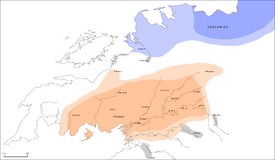Svacchavamsa Empire
Svacchavamsa Empire | |||||||
|---|---|---|---|---|---|---|---|
 | |||||||
| Capital | Prakilapur | ||||||
• 322-313 BCE | Ravamsa | ||||||
• | ... | ||||||
• 247-245 BCE | Devdaha | ||||||
• 245-198 BCE | Ravigupta | ||||||
| Historical era | Pre-Irfanic Satria | ||||||
| |||||||
The Svacchavamsa Empire, was a state that unified almost all of Vedic Satria for over one hundred years from 322 to 198 BCE. It emerged as a rebellion against the preciding Krala Empire lead by Ravamsa and members of the priesthood who were frustrated by the lack of peity in Kitaji at the time. Many scions of the Svacchavamsas continued to rule parts of Satria for many decades after the reign of Ravigupta, but the empire ended after Ravigupta's filicide. Svacchavamsa rulers were deeply entertwined with the religion of the Satrians and devoted public resources to the formation of temples and documentation of many rituals, especially the Martandabhajana (aka Solar Hymnal), which is the earliest record of the Parbhan oral tradition. Later Svacchavamsa kings, most notably Devdaha and Ravigupta, attempted to assert their status as divine beings, which brought them into conflict with some members of the priestly class and especially with religious figures emerging from the declining Sorsanid Empire.
History
Krala Mutiny
Ravamsa was an aristocratic figure in the Krala Empire who served as a commander in the army. His pedigree is attested to by an epitaph on a victory stele which refered to him as "seven-lived" and a reincarnation of the legendary figure Asveta, a status only granted to the most prestigious members of society. Various victories of the late Kralas are attributed to Ravamsa, primarily against rebellious cities and towns that had previously been incorporated into the Krala empire. The most important victory appears to have been late in his tenure, won against a similarly well-bred warrior named Durg who led an army from Lunagadi. According to the Krala account, Ravamsa personal slew ten thousand men and one hundred thousand perished. Although an exegerration, it does seem that Lunagadi was abandonded for several years following the struggle, probably as a result of the lives lost during the war. The reigning Krala ruler, Chanakyakrala, who had already faced several rebellions, made the unusual order to extinguish the lines of the aristocrats. The concept of extinction was not unknown to Satrian society--it was used to punish cannibals for example--but the concept of removing such a large number of reincarnated souls from existence was probably very extreme. The ritual process of extinguishment involved decapitating and encasing the head of victims in clay. After this, by general agreement, priests would stop assigning those names to future children, ultimately bringing the cycle to an end.
Ravamsa obliged his masters, but apparently resented the action along with major philosophical figures of the Krala state, such as Jandaya.
